2023届高三英语二轮复习:五种简单基本句型课件 (48张ppt)
文档属性
| 名称 | 2023届高三英语二轮复习:五种简单基本句型课件 (48张ppt) |  | |
| 格式 | pptx | ||
| 文件大小 | 3.9MB | ||
| 资源类型 | 教案 | ||
| 版本资源 | 通用版 | ||
| 科目 | 英语 | ||
| 更新时间 | 2022-10-04 21:48:41 | ||
图片预览

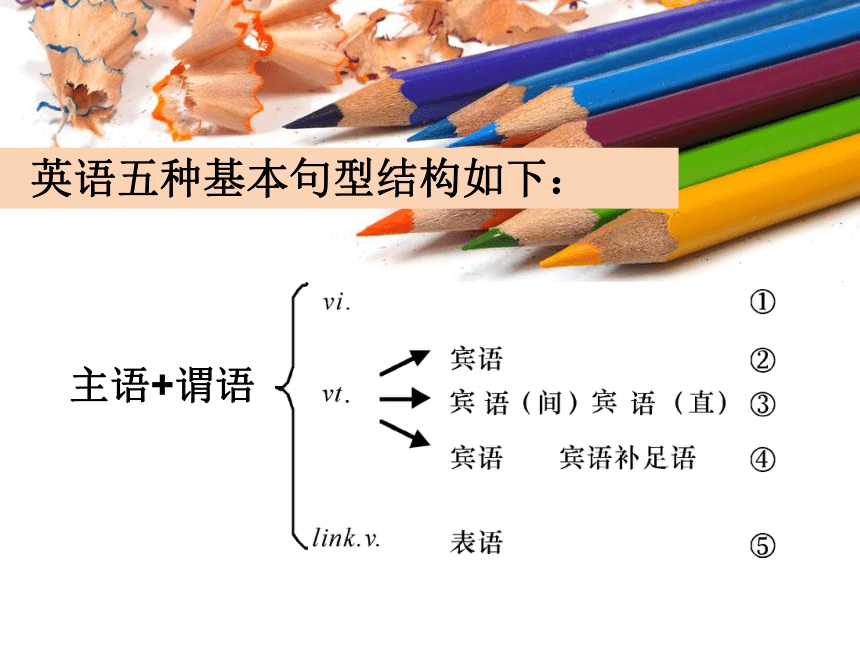
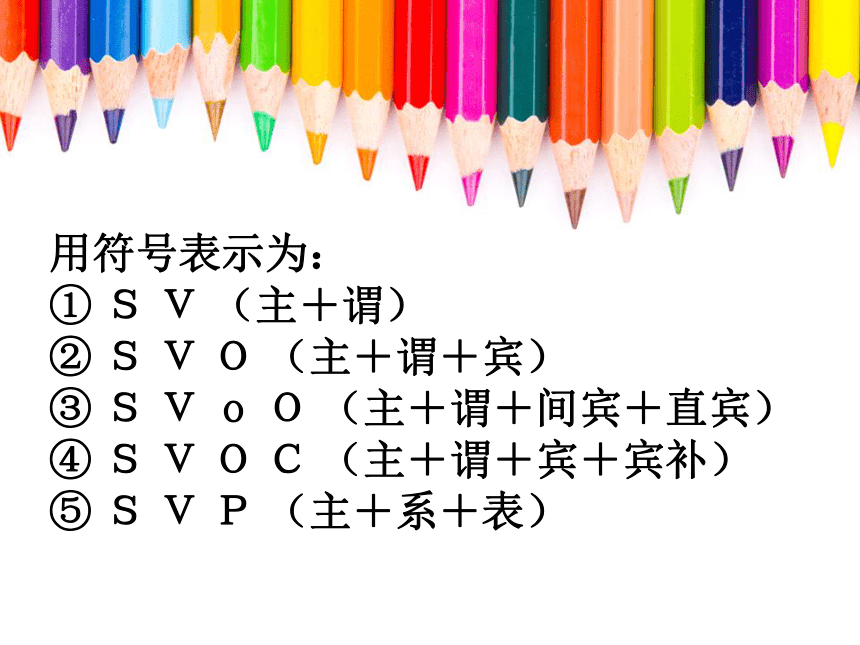
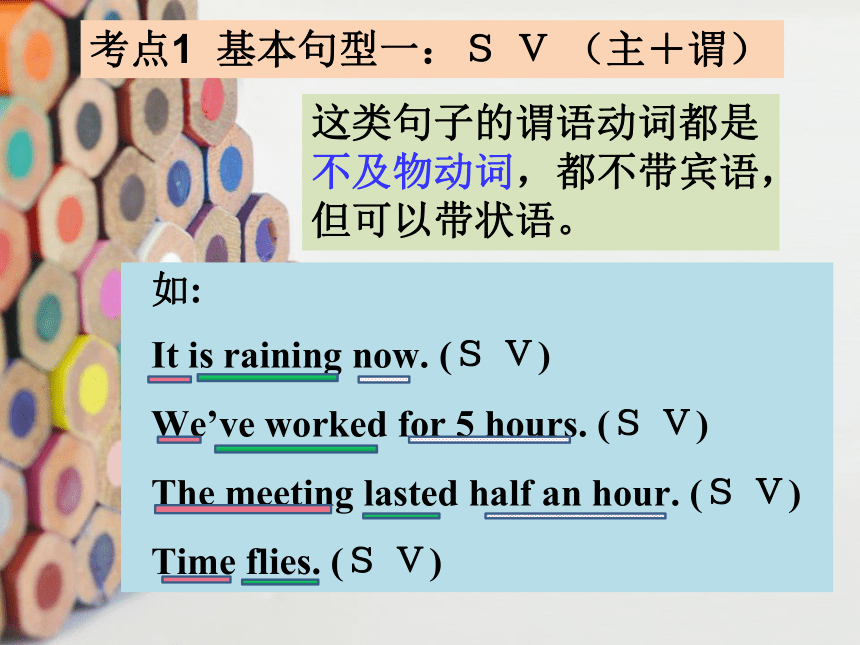
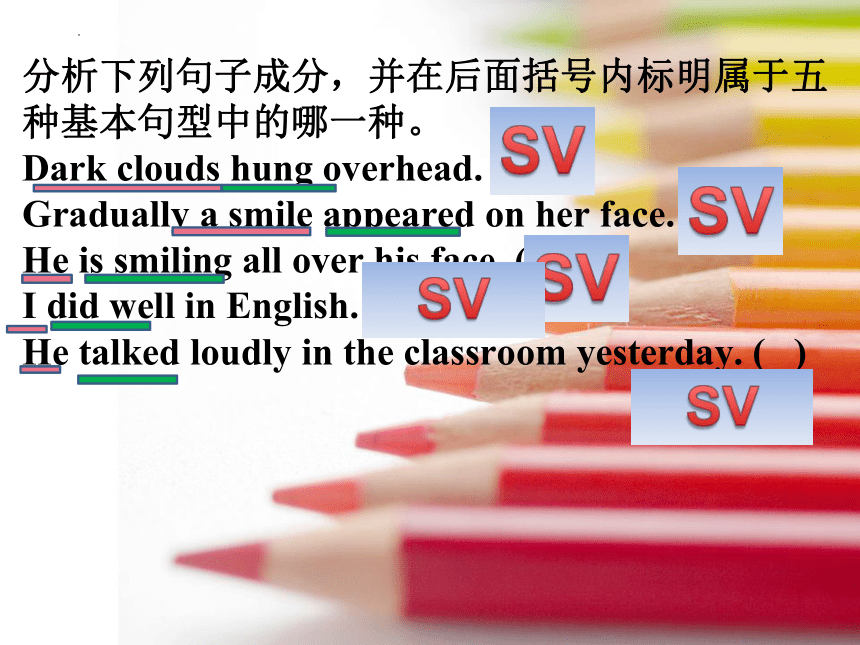




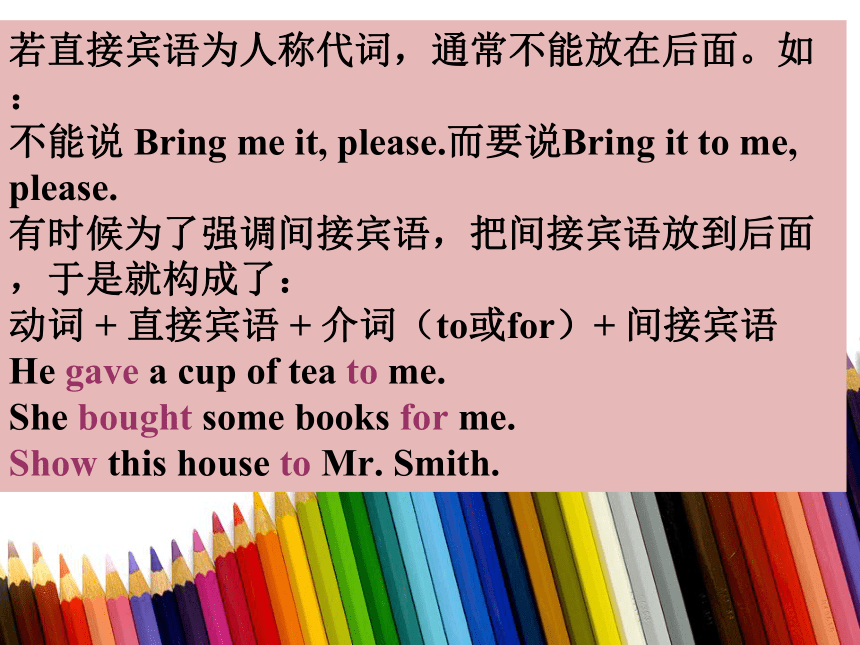

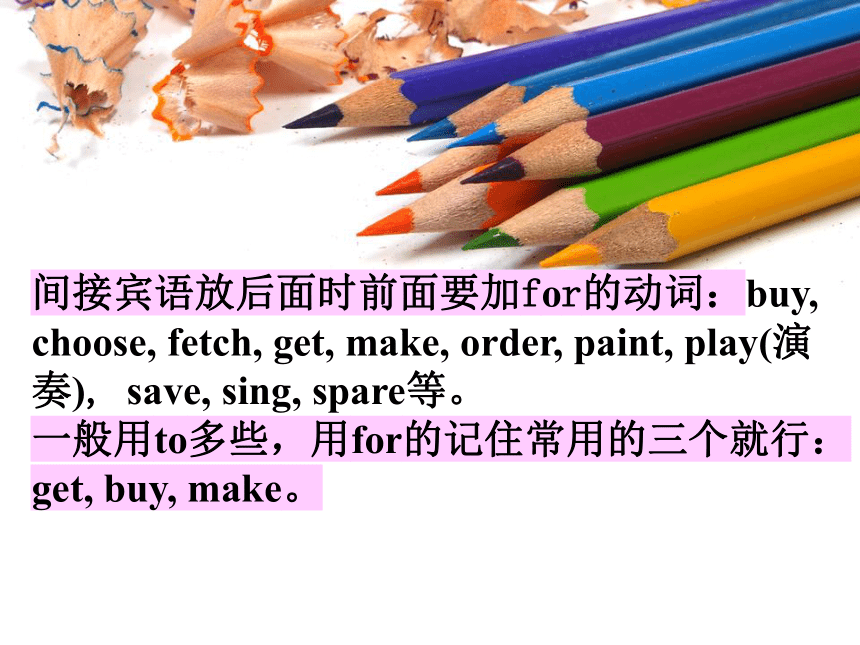
文档简介
(共48张PPT)
简单句的五种基本结构
①主谓
②主谓宾
③主系表
④双宾语
⑤复合宾语
主语+谓语
英语五种基本句型结构如下:
用符号表示为:
① S V (主+谓)
② S V O (主+谓+宾)
③ S V o O (主+谓+间宾+直宾)
④ S V O C (主+谓+宾+宾补)
⑤ S V P (主+系+表)
考点1 基本句型一:S V (主+谓)
这类句子的谓语动词都是不及物动词,都不带宾语,但可以带状语。
如:
It is raining now. (S V)
We’ve worked for 5 hours. (S V)
The meeting lasted half an hour. (S V)
Time flies. (S V)
分析下列句子成分,并在后面括号内标明属于五种基本句型中的哪一种。
Dark clouds hung overhead. ( )
Gradually a smile appeared on her face. ( )
He is smiling all over his face. ( )
I did well in English. ( )
He talked loudly in the classroom yesterday. ( )
SV
SV
SV
SV
SV
考点2 基本句型三: S V O (主+谓+宾)
此结构是由“主语+及物动词(词组)+宾语”构成。
She likes English.
We planted a lot of trees on the farm yesterday
分析下列句子成分,并在后面括号内标明属于五种基本句型中的哪一种。
1.People all over the world speak English.
2.Jim cannot dress himself.
3.All of us believe that Jack is an honest boy.
4.He did not know what to say.
5.He just wanted to stay at home.
6.He practices speaking English every day.
SVC
SVC
SVC
SVC
SVC
SVC
考点3 基本句型四:
SVoO(主+谓+间宾 +直宾)
有些及物动词可以有两个宾语,如:give“给”,pass“递”,bring“带”,show“展示”。这两个宾语通常一个指人,为间接宾语;一个指物,为直接宾语。间接宾语一般位于直接宾语之前。
表示传递精神或物质
一般的顺序为:动词 + 间接宾语 + 直接宾语
如:He gave me a cup of tea. (S V o O)
She bought me some books. (S V o O)
若直接宾语为人称代词,通常不能放在后面。如:
不能说 Bring me it, please.而要说Bring it to me, please.
有时候为了强调间接宾语,把间接宾语放到后面,于是就构成了:
动词 + 直接宾语 + 介词(to或for)+ 间接宾语
He gave a cup of tea to me.
She bought some books for me.
Show this house to Mr. Smith.
常跟双宾语的及物动词有:
间接宾语放后面时前面要加to的动词:allow, bring, deny, give, hand, leave, lend, offer, owe, pass, pay, permit, promise, read, refuse, sell, send, show, teach, tell, wish, write等
间接宾语放后面时前面要加for的动词:buy, choose, fetch, get, make, order, paint, play(演奏), save, sing, spare等。
一般用to多些,用for的记住常用的三个就行:get, buy, make。
He got an English-Chinese Dictionary for me.
She bought a book for John.
My uncle made a kite for me.
分析下列句子成分,口头说出间接宾语和直接宾语。
1. She ordered herself a new dress.
2. She cooked her husband a delicious meal.
3. He brought you a dictionary.
4. He denies her nothing.
5. I showed him my pictures.
6. I gave my car a wash.
7. I told him that the bus was late.
8. He showed me how to run the machine.
考点4 基本句型五:
SVOC (主+谓+宾+宾补)
有些动词虽然是及物动词,但是只跟一个宾语还不能表达完整的意思,宾语后必须加上一个补充成分才能使意思完整。所加的成分就是宾语补足语。
宾语和宾语补足语构成逻辑上的主谓关系,它们一起构成复合宾语。
看下面这句话:
He asked me to lend him some money.他让我借给他一些钱。
“me”是宾语,
“to lend him some money”是宾补,
宾语和宾补合一起意思为“我借给他一些钱”
从意思上看,这像一句话,“我”是主语,“借给他一些钱”是谓语部分,但在英语原句中,它们却不是真正的主谓关系,而是逻辑上的“主谓关系”,即:从意思上看像主谓关系,而实际上不是。
判断下列句中画线部分是否是宾语补足语。(是的填T,不是的填F)
1. I want him to come at once. ( )
2. He lent me some money. ( )
3. He made the boy cry again. ( )
4. The teacher found him cheating in the exam. ( )
5. Don’t leave the door open at night. ( )
T
F
T
T
T
分析下列句子并划分成分,在后面的括号内标明是什么充当句子的宾语补足语。
1. They appointed him manager. ( )
2. They painted the door green. ( )
3. He pushed the door open. ( )
4. Don’t keep the lights burning.. ( )
5. What makes him think so ( )
6. We saw him out. ( )
7. I’ll have my bike repaired. ( )
manager
名词
green
形容词
open
形容词
burning
现在分词
think so
省略to的不定式
out
副词
repaired
过去分词
考点5 基本句型二:
S V P (主+系+表)
系动词主要是be;但还有一些实义动词候有时候也可作系动词,这类系动词有人称之为半系动词。
半系动词后面大部分情况跟形容词作表语。
A. 如何辨别系动词
有些动词既可作连系动词,又可以作实义动词。如何来辨别呢?有一个最简便的方法,即用连系动词be替换句子中的这些动词,句子仍然成立且句意变化不大就是连系动词;反之,不能替换的,就是实义动词。
如:
1.She looks beautiful. (looks变为is之后,她是美丽的,句意没有大的变化,looks是系动词。)
2.Look at the picture.(look不能换为be, 为实义动词。)
3.He felt the book with his right hand.(feel是“摸”的意思,不能换为was, 是实义动词。)
4.The silk feels soft.(这种丝绸摸起来很柔软,feels换为is之后,句意变化不大,因此是系动词。)
可以看出:半系动词后面大部分情况跟形容词作表语。
辨别下列斜体动词是系动词还是实义动词。
1.The door stays open at night.
2.He tasted the food, and the food tasted delicious.
3.The book still lies open on the desk.
4.What he said proved true.
5.He can’t proved his theory(理论).
1.系动词
2. 实义动词;连系动词
3.连系动词
4. 连系动词
5.实义动词
B. 常见的系动词
1.状态系动词
用来表示主语状态,只有be一词。如:
He is a teacher. 他是一名教师。
持续系动词
用来表示主语继续或保持一种状况或态度,主要有keep, remain, stay, lie, stand。如:
He kept silent at the meeting. 他开会时保持沉默。
This matter remains a mystery. 此事仍是一个谜。
The food stays fresh in the fridge.
食物在冰箱里仍然很新鲜。
The house stood empty for years.房子空了数年。
He lies awake in bed.他躺在床上,醒着。
表“像”系动词
用来表示“看起来像”这一概念,主要有seem, appear, look。如:
Something seems wrong. 好像出差错了。
He appears young. 他看起来很年轻。
感官系动词
感官系动词主要有look“看起来”,feel“摸起来”, smell“闻起来”, sound“听起来”, taste“尝起来”。
This kind of cloth feels very soft.
这种布手感很软。
This flower smells very sweet.
这朵花闻起来很香。
变化系动词
这些系动词表示主语变成什么样。变化系动词主要有become, grow, turn, fall, get, go, come, run
He became mad after that. 自那之后,他疯了。
She grew rich within a short time.
她没多长时间就富了。
He fell ill yesterday.他昨天病了。
Eggs go bad easily in summer. 蛋夏天容易变坏。
His face went red.他的脸变红了。
What he had dreamt of came true.
他的梦想实现了。
Still waters run deep.静水流深。
终止系动词
表示主语已终止动作,主要有prove, turn out, 表达“证实”,“变成”之意。如:
The rumor proved false. 这谣言证实有假。
His plan turned out a success.
他的计划终于成功了。(turn out表终止性结果)
What he predicted turned out (to be) wrong.
他预言的结果是错的。
用下划线画出下列句中的系动词。
1.His advice proved right.
2.The shop stays open till 8 o’clock.
3.The machine went wrong.
4.All these efforts seem in vain.
5.These words sound reasonable.
6.The room soon became crowded.
7.The days are getting longer and longer.
8.He fell ill yesterday.
9.Trees turn green in spring.
10.What you said sounds great.
C. 系动词不能单独作谓语,要和表语一起作谓语
He is a student. (S V P)
Your idea sounds great. (S V P)
D. 在一个英语单句中,一般情况要有谓语动词
要注意:介词短语和形容词不能单独作谓语,要和系动词一起作谓语。
改错:
① Our school very beautiful and we like it very much.
② Your book on the desk.
答案及解析:
Our school is very beautiful and we like it very much. (句中没有谓语动词)
Your book is on the desk.(句中没有谓语动词)
考点6 there be 句型
此句型是由“there + be + 主语 + 状语”构成,用以表达“存在有”。它其实是倒装的一种情况,实义主语位于谓语动词 be 之后,there 仅为引导词(也有看作形式主语的),并无实际意义。
A. be 要与其后的主语在人称和数上保持一致,如果be后实义主语是多个并列项时,要按就近一致原则,与第一项保持一致。
There ______a bird in the tree.
There ______many apples on the tree.
There ______a pencil and two rulers on the desk.
There ______two rulers and a pencil on the desk.
(
is
(主语a bird是单数,所以用there is)
(主语many apples是复数,所以用there are)
is
(第一项是a pencil,单数,所以用there is)
are
第一项是two rulers,复数,所以用there are)
B. 可用 live, stand, come, go, lie, remain, exist, arrive等词代替be动词。此时还表示“存在有”,但表意要更具体一些。
There lived an old man at the foot of the mountain.
在山脚下住着一位老人。
(不但“有”,而且“住”在那里。)
There exists no air on the moon.
月球上没有空气。(exist是“存在”的意思)
There lies a book on the desk.
课桌上平放着一本书。
(不但“有”,而且说明书是“平放”在那里。)
There stands a tree on the hill.
山上矗立着一棵树。
(不但说明“有”树,而且说明了“树”很挺拔。)
①______ a certain doubt among the students as to the necessity of the work.
A. It existed B. There existed
C. They had D. There had
②______ a beautiful palace ______ the foot of the hill.
A. There stand; at
B. There stands; under
C. Stands there; under
D. There stands; at
C. here seem/ happen/ used to be及there live/ lie/ stand句型的否定句和疑问句的变法。
根据汉语提示完成句子:
①下周将有两场会,不是吗?
There ______ going to be two meetings next week, ______ there
②不会再有流血冲突,是吗?
There will be no blood, ______there
③似乎出了问题,不是吗?
There seems to be something wrong, ______ there
are
aren’t
won’t
doesn’t
④似乎有误解,是吗?
There appeared to be a misunderstanding, ______ there
⑤碰巧那时附近有辆公交车。
There ____________ (happen) to be a bus nearby at that time.
⑥过去这里有条小河,不是吗?
There used to be a river here, ______ there
过去这个森林里生活着一只老虎,不是吗?
There lived a tiger in the forest, ______ there
didn’t
happened
didn’t
usedn’t
didn’t
D. there be 与have 的区别
there be …“某地有某物,某时有某事”;
have 表示“某人拥有某物”。
提示:没有there have这种表示“有”的方法。
改错:
①There has a book on the desk.
②There will have a meeting this evening.
is
be
正确利用两个“有”there be与have
1.我有许多好朋友。
2.今天晚上将有一场电影。
3.公园内有许多人。
4.树上有许多小鸟。
5.一条狗有四条腿和一条尾巴。
I have many good friends.
There will be a movie tonight.
There are many people in the park.
There are lots of birds in the tree.
A dog has four legs and a tail.
考点7 双重谓语(仅供了解)
典型例句:
1. He left this morning very glad.
2. She left a shy girl and returned a young mother.
句①意为:上午离开时,他很开心。
句②意为:她离开时还是一个害羞的女孩,回来时却是一位年轻的母亲。
分析:双重谓语的基本形式是:行为动词+表语,后面的名词或形容词说明主语从事该行为时所处的状态。用作双重谓语的动词多为那些表示位置移动变化的行为动词,如return,leave,go,come,arrive,start等。
简单句的五种基本结构
①主谓
②主谓宾
③主系表
④双宾语
⑤复合宾语
主语+谓语
英语五种基本句型结构如下:
用符号表示为:
① S V (主+谓)
② S V O (主+谓+宾)
③ S V o O (主+谓+间宾+直宾)
④ S V O C (主+谓+宾+宾补)
⑤ S V P (主+系+表)
考点1 基本句型一:S V (主+谓)
这类句子的谓语动词都是不及物动词,都不带宾语,但可以带状语。
如:
It is raining now. (S V)
We’ve worked for 5 hours. (S V)
The meeting lasted half an hour. (S V)
Time flies. (S V)
分析下列句子成分,并在后面括号内标明属于五种基本句型中的哪一种。
Dark clouds hung overhead. ( )
Gradually a smile appeared on her face. ( )
He is smiling all over his face. ( )
I did well in English. ( )
He talked loudly in the classroom yesterday. ( )
SV
SV
SV
SV
SV
考点2 基本句型三: S V O (主+谓+宾)
此结构是由“主语+及物动词(词组)+宾语”构成。
She likes English.
We planted a lot of trees on the farm yesterday
分析下列句子成分,并在后面括号内标明属于五种基本句型中的哪一种。
1.People all over the world speak English.
2.Jim cannot dress himself.
3.All of us believe that Jack is an honest boy.
4.He did not know what to say.
5.He just wanted to stay at home.
6.He practices speaking English every day.
SVC
SVC
SVC
SVC
SVC
SVC
考点3 基本句型四:
SVoO(主+谓+间宾 +直宾)
有些及物动词可以有两个宾语,如:give“给”,pass“递”,bring“带”,show“展示”。这两个宾语通常一个指人,为间接宾语;一个指物,为直接宾语。间接宾语一般位于直接宾语之前。
表示传递精神或物质
一般的顺序为:动词 + 间接宾语 + 直接宾语
如:He gave me a cup of tea. (S V o O)
She bought me some books. (S V o O)
若直接宾语为人称代词,通常不能放在后面。如:
不能说 Bring me it, please.而要说Bring it to me, please.
有时候为了强调间接宾语,把间接宾语放到后面,于是就构成了:
动词 + 直接宾语 + 介词(to或for)+ 间接宾语
He gave a cup of tea to me.
She bought some books for me.
Show this house to Mr. Smith.
常跟双宾语的及物动词有:
间接宾语放后面时前面要加to的动词:allow, bring, deny, give, hand, leave, lend, offer, owe, pass, pay, permit, promise, read, refuse, sell, send, show, teach, tell, wish, write等
间接宾语放后面时前面要加for的动词:buy, choose, fetch, get, make, order, paint, play(演奏), save, sing, spare等。
一般用to多些,用for的记住常用的三个就行:get, buy, make。
He got an English-Chinese Dictionary for me.
She bought a book for John.
My uncle made a kite for me.
分析下列句子成分,口头说出间接宾语和直接宾语。
1. She ordered herself a new dress.
2. She cooked her husband a delicious meal.
3. He brought you a dictionary.
4. He denies her nothing.
5. I showed him my pictures.
6. I gave my car a wash.
7. I told him that the bus was late.
8. He showed me how to run the machine.
考点4 基本句型五:
SVOC (主+谓+宾+宾补)
有些动词虽然是及物动词,但是只跟一个宾语还不能表达完整的意思,宾语后必须加上一个补充成分才能使意思完整。所加的成分就是宾语补足语。
宾语和宾语补足语构成逻辑上的主谓关系,它们一起构成复合宾语。
看下面这句话:
He asked me to lend him some money.他让我借给他一些钱。
“me”是宾语,
“to lend him some money”是宾补,
宾语和宾补合一起意思为“我借给他一些钱”
从意思上看,这像一句话,“我”是主语,“借给他一些钱”是谓语部分,但在英语原句中,它们却不是真正的主谓关系,而是逻辑上的“主谓关系”,即:从意思上看像主谓关系,而实际上不是。
判断下列句中画线部分是否是宾语补足语。(是的填T,不是的填F)
1. I want him to come at once. ( )
2. He lent me some money. ( )
3. He made the boy cry again. ( )
4. The teacher found him cheating in the exam. ( )
5. Don’t leave the door open at night. ( )
T
F
T
T
T
分析下列句子并划分成分,在后面的括号内标明是什么充当句子的宾语补足语。
1. They appointed him manager. ( )
2. They painted the door green. ( )
3. He pushed the door open. ( )
4. Don’t keep the lights burning.. ( )
5. What makes him think so ( )
6. We saw him out. ( )
7. I’ll have my bike repaired. ( )
manager
名词
green
形容词
open
形容词
burning
现在分词
think so
省略to的不定式
out
副词
repaired
过去分词
考点5 基本句型二:
S V P (主+系+表)
系动词主要是be;但还有一些实义动词候有时候也可作系动词,这类系动词有人称之为半系动词。
半系动词后面大部分情况跟形容词作表语。
A. 如何辨别系动词
有些动词既可作连系动词,又可以作实义动词。如何来辨别呢?有一个最简便的方法,即用连系动词be替换句子中的这些动词,句子仍然成立且句意变化不大就是连系动词;反之,不能替换的,就是实义动词。
如:
1.She looks beautiful. (looks变为is之后,她是美丽的,句意没有大的变化,looks是系动词。)
2.Look at the picture.(look不能换为be, 为实义动词。)
3.He felt the book with his right hand.(feel是“摸”的意思,不能换为was, 是实义动词。)
4.The silk feels soft.(这种丝绸摸起来很柔软,feels换为is之后,句意变化不大,因此是系动词。)
可以看出:半系动词后面大部分情况跟形容词作表语。
辨别下列斜体动词是系动词还是实义动词。
1.The door stays open at night.
2.He tasted the food, and the food tasted delicious.
3.The book still lies open on the desk.
4.What he said proved true.
5.He can’t proved his theory(理论).
1.系动词
2. 实义动词;连系动词
3.连系动词
4. 连系动词
5.实义动词
B. 常见的系动词
1.状态系动词
用来表示主语状态,只有be一词。如:
He is a teacher. 他是一名教师。
持续系动词
用来表示主语继续或保持一种状况或态度,主要有keep, remain, stay, lie, stand。如:
He kept silent at the meeting. 他开会时保持沉默。
This matter remains a mystery. 此事仍是一个谜。
The food stays fresh in the fridge.
食物在冰箱里仍然很新鲜。
The house stood empty for years.房子空了数年。
He lies awake in bed.他躺在床上,醒着。
表“像”系动词
用来表示“看起来像”这一概念,主要有seem, appear, look。如:
Something seems wrong. 好像出差错了。
He appears young. 他看起来很年轻。
感官系动词
感官系动词主要有look“看起来”,feel“摸起来”, smell“闻起来”, sound“听起来”, taste“尝起来”。
This kind of cloth feels very soft.
这种布手感很软。
This flower smells very sweet.
这朵花闻起来很香。
变化系动词
这些系动词表示主语变成什么样。变化系动词主要有become, grow, turn, fall, get, go, come, run
He became mad after that. 自那之后,他疯了。
She grew rich within a short time.
她没多长时间就富了。
He fell ill yesterday.他昨天病了。
Eggs go bad easily in summer. 蛋夏天容易变坏。
His face went red.他的脸变红了。
What he had dreamt of came true.
他的梦想实现了。
Still waters run deep.静水流深。
终止系动词
表示主语已终止动作,主要有prove, turn out, 表达“证实”,“变成”之意。如:
The rumor proved false. 这谣言证实有假。
His plan turned out a success.
他的计划终于成功了。(turn out表终止性结果)
What he predicted turned out (to be) wrong.
他预言的结果是错的。
用下划线画出下列句中的系动词。
1.His advice proved right.
2.The shop stays open till 8 o’clock.
3.The machine went wrong.
4.All these efforts seem in vain.
5.These words sound reasonable.
6.The room soon became crowded.
7.The days are getting longer and longer.
8.He fell ill yesterday.
9.Trees turn green in spring.
10.What you said sounds great.
C. 系动词不能单独作谓语,要和表语一起作谓语
He is a student. (S V P)
Your idea sounds great. (S V P)
D. 在一个英语单句中,一般情况要有谓语动词
要注意:介词短语和形容词不能单独作谓语,要和系动词一起作谓语。
改错:
① Our school very beautiful and we like it very much.
② Your book on the desk.
答案及解析:
Our school is very beautiful and we like it very much. (句中没有谓语动词)
Your book is on the desk.(句中没有谓语动词)
考点6 there be 句型
此句型是由“there + be + 主语 + 状语”构成,用以表达“存在有”。它其实是倒装的一种情况,实义主语位于谓语动词 be 之后,there 仅为引导词(也有看作形式主语的),并无实际意义。
A. be 要与其后的主语在人称和数上保持一致,如果be后实义主语是多个并列项时,要按就近一致原则,与第一项保持一致。
There ______a bird in the tree.
There ______many apples on the tree.
There ______a pencil and two rulers on the desk.
There ______two rulers and a pencil on the desk.
(
is
(主语a bird是单数,所以用there is)
(主语many apples是复数,所以用there are)
is
(第一项是a pencil,单数,所以用there is)
are
第一项是two rulers,复数,所以用there are)
B. 可用 live, stand, come, go, lie, remain, exist, arrive等词代替be动词。此时还表示“存在有”,但表意要更具体一些。
There lived an old man at the foot of the mountain.
在山脚下住着一位老人。
(不但“有”,而且“住”在那里。)
There exists no air on the moon.
月球上没有空气。(exist是“存在”的意思)
There lies a book on the desk.
课桌上平放着一本书。
(不但“有”,而且说明书是“平放”在那里。)
There stands a tree on the hill.
山上矗立着一棵树。
(不但说明“有”树,而且说明了“树”很挺拔。)
①______ a certain doubt among the students as to the necessity of the work.
A. It existed B. There existed
C. They had D. There had
②______ a beautiful palace ______ the foot of the hill.
A. There stand; at
B. There stands; under
C. Stands there; under
D. There stands; at
C. here seem/ happen/ used to be及there live/ lie/ stand句型的否定句和疑问句的变法。
根据汉语提示完成句子:
①下周将有两场会,不是吗?
There ______ going to be two meetings next week, ______ there
②不会再有流血冲突,是吗?
There will be no blood, ______there
③似乎出了问题,不是吗?
There seems to be something wrong, ______ there
are
aren’t
won’t
doesn’t
④似乎有误解,是吗?
There appeared to be a misunderstanding, ______ there
⑤碰巧那时附近有辆公交车。
There ____________ (happen) to be a bus nearby at that time.
⑥过去这里有条小河,不是吗?
There used to be a river here, ______ there
过去这个森林里生活着一只老虎,不是吗?
There lived a tiger in the forest, ______ there
didn’t
happened
didn’t
usedn’t
didn’t
D. there be 与have 的区别
there be …“某地有某物,某时有某事”;
have 表示“某人拥有某物”。
提示:没有there have这种表示“有”的方法。
改错:
①There has a book on the desk.
②There will have a meeting this evening.
is
be
正确利用两个“有”there be与have
1.我有许多好朋友。
2.今天晚上将有一场电影。
3.公园内有许多人。
4.树上有许多小鸟。
5.一条狗有四条腿和一条尾巴。
I have many good friends.
There will be a movie tonight.
There are many people in the park.
There are lots of birds in the tree.
A dog has four legs and a tail.
考点7 双重谓语(仅供了解)
典型例句:
1. He left this morning very glad.
2. She left a shy girl and returned a young mother.
句①意为:上午离开时,他很开心。
句②意为:她离开时还是一个害羞的女孩,回来时却是一位年轻的母亲。
分析:双重谓语的基本形式是:行为动词+表语,后面的名词或形容词说明主语从事该行为时所处的状态。用作双重谓语的动词多为那些表示位置移动变化的行为动词,如return,leave,go,come,arrive,start等。
